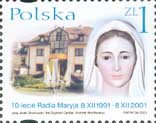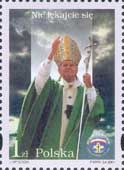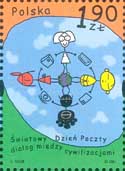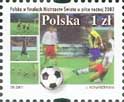| |
|
The Polish Post will publish a series of sixteen postal stamps entitled "Polish Millennium" in November this year. The purpose of the emission includes a summary of 1000 years of the history, culture, and science in Poland from the perspective of the 21st century. Every stamp of the face value of PLN 1.00 has been devoted to a different field of life. The concept is based on the rule of comparing and associating events and personalities from the newest history of Poland with past times.
So individual stamps, grouped according to their topics, represent:
CHRISTIANITY
The Pope John Paul II against the background of a fragment of Gniezno Doors representing the image of St. Wojciech. PARLIAMENTARISM
President Lech Wałęsa taking the oath in Sejm and a fragment of the cover of the Constitution of May 3rd, 1791. HISTORY OF THE POLITICICAL PUBLICISM
Fragment of the cover of the magazine "Głos Wolny Wolno¶ć Ubezpieczaj±cy" from the Department of Old Prints of the Public Library of Warsaw, the cover of the first issue of "Kultura", and "Zniewolony Umysł" by Czesław Miłosz - property of the Literary Institute in Paris, as well as the cover of "O skutecznym rad sposobie" - property of the Yagiellonian Library in Cracow. THEATRE
Wojciech Bogusławski (1757-1829) and Jerzy Grotowski (1933-1999). The background represents a fragment of the manuscript of the 3rd part of "Dziady" by A. Mickiewicz, included in the collections of the Library of the Polish Academy of Sciences in Kórnik and the logo of Cricot 2 theatre of Tadeusz Kantor. INDEPENDENCE
Józef Piłsudski (1867-1935) against the background with electoral campaign posters of 1989. INTERNATIONALIST TRADITIONS OF THE POLISH MILITARY FORCES
The NATO emblem and a portrait of General Kazimierz Pułaski (1746-79), acc. to a 19th century lithography. Since 1777 Pułaski had been fighting for the independence of the United States and he died in Savannah, considered to be a national hero of the United States. ASTRONOMY
Nicolaus Copernicus (1473-1543) and Aleksander Wolszczan (born in 1946) - an eminent Polish astronomer who discovered the first planetary system outside the Sun. A fragment of "De revolucionibus" by Nicolaus Copernicus at the background. EDUCATION
A fragment of a wood engraving representing Jan of Głogów (1445-1507), called Głogowczyk or Głogowit, an eminent mathematician, astronomer, theologist, professor of the Cracow Academy, teacher of Nicolaus Copernicus. The second part of the stamp represents the personality of the contemporary physicist Tadeusz Kotarbiński (1886-1981). TRADITIONS OF THE POLISH ARMY
A fragment of the picture "Bitwa pod Grunwaldem" by Jan Matejko at the National Museum in Warsaw and a poster from the times of the Warsaw Battle in 1920 entitled "Do broni", property of the Yagiellonian Library in Cracow. INDEPENDENCE STRAINS
A lithography of Villan representing the Belvedere Group: a group of plotters commanded by Ludwik Nabielak, who attacked Belvedere on November 29th, 1830, which was the seat of the Great Prince Konstanty, and thus who started the November Uprising. The lithography represents the following persons, from the left side: Karol Pankiewicz, Walenty Krosnowski, Wincenty Kobylański, Aleksander ¦więtosławski. There is a seal of Marian Langiewicz, dictator at the initial period of the January Uprising in 1863 in the right-hand bottom corner of the stamp. The background represents the vignette of the information newspaper of the Home Army AK "Warszawa Walczy". The stamp also presents a scene of the Warsaw Uprising coming from a photograph taken by Janusz Cegiełła on August 20th, 1944. ART
A fragment of a sculpture representing the head of the John the Apostle from "Ołtarz Mariacki" by Wit Stwosz in Cracow. The second part of the stamp contains an image of the sculpture-auto-portrait of Magdalena Abakanowicz. MUSIC
Krzysztof Penderecki (born in 1933) and a portrait of Fryderyk Chopin (1810-49). A fragment of the notes of Mazurka No. 10, opus 50 by Karol Szymanowski (1882-1937), included in the collections of the National Library, is visible at the background. POLAND IN THE EUROPEAN SYSTEM
Portrait of Jan III Sobieski from the collections of the Royal Castle in Warsaw and the emblem of the European Union. POLISH SYMBOLS
The Medieval panorama of Cracow according to a wood engraving from the collections of the Yagiellonian Library in Cracow and the picture of the Royal Castle in Warsaw. LANGUAGE, THE LETTERS, AND LITERATURE
Winner of the Nobel Prize Wisława Szymborska (born in 1923) and Mikołaj Rej (1505-69) according to a wood engraving from the Yagiellonian Library in Cracow. SPORT
Janusz Kusociński (1907-40) and Robert Korzeniowski.
On the day of introducing the stamps into the market, there will be sold four first day envelopes (FDC) with a special date seal in the Post Office Warsaw 1.
The first FDC envelope covering the following topics: Christianity, parliamentarism, international traditions of the Polish military forces, and independence, represent a Polish hussar, a special label issued in 1916 at the occasion of the 125th anniversary of the adoption of the Constitution of May 3rd, hence the dates: 1791-1616, as well as a medal Virtuti Militari.
The second FDC envelope, covering the history of the political publicism, theatre, astronomy, and education, represents Hugon Kołł±taj, the emblem of the Yagiellonian University, as well as a facsimile of the resolution of the National Education Commission (KEN) concerning the functioning of schools.
Another FDC envelope, covering topics including traditions of the Polish army, Poland in the European system, Polish symbols, and independence movements, presents Stefan Batory on the Gdańsk ducat of 1583, Piłsudski on a silver 100-mark coin of 1922, the emblem of the Yagiellonian Library, and a wood engraving representing Zygmunt Stary from "Chronica Polonarum" of 1521.
The fourth FDC envelope, covering art, music, language, letters, and literature, as well as sport, presents the portrait of Adam Mickiewicz by Horowitz from the book entitled "Opisy I obrazy", published by Macierz Polska in Lvov in 1909, as well as "the bag" and seal of Tadeusz Kantor. The intention of the artist included the presentation of various shades of the Polish art, starting with the romantic current with Adam Mickiewicz as its most eminent representative, up to the ironic, sarcastic look to Tadeusz Kantor's art.
The special date seal presents one gross of Bolesław Chrobry and the inscription Polonia from the logo of Expo -92 in Sevilla.
|










